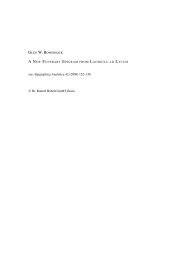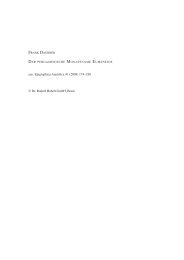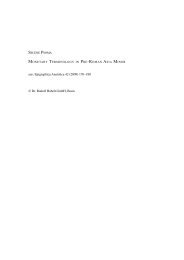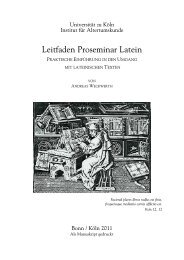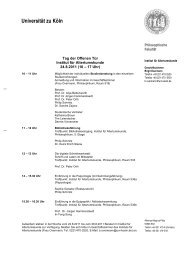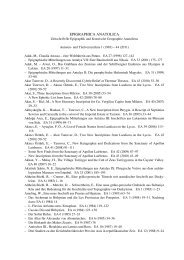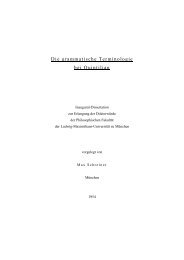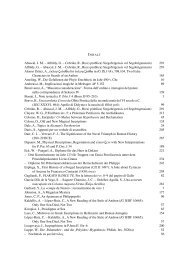039-060 malay-ricl.indd
039-060 malay-ricl.indd
039-060 malay-ricl.indd
You also want an ePaper? Increase the reach of your titles
YUMPU automatically turns print PDFs into web optimized ePapers that Google loves.
HASAN MALAY – MARIJANA RICL<br />
TWO NEW HELLENISTIC DECREES FROM AIGAI IN AIOLIS<br />
aus: Epigraphica Anatolica 42 (2009) 39–60<br />
© Dr. Rudolf Habelt GmbH, Bonn
TWO NEW HELLENISTIC DECREES FROM AIGAI IN AIOLIS<br />
In 2004, during the fi rst season of archaeological excavations of Aiolian Aigai, a fortunate fi nd<br />
of an opisthographic stele considerably enriched our knowledge of this city’s history in the Hellenistic<br />
period. The publication of this fi nd was entrusted by Prof. Ersin Doğer, the director of<br />
the excavation, to Hasan Malay, who later offered Marijana Ricl to join him in deciphering both<br />
sides of the stone. With some interruptions, our joint work continued until the early months of<br />
2010. Not wishing to delay any longer the fi nal publication of two important new documents, we<br />
offer them here to the scientifi c community 1 .<br />
Decree I (front side):<br />
The City of Aigai Decrees Divine Honours for Seleukos and Antiochos<br />
[Figs. 1–2 and 5]<br />
Tall stele of local hard brownish stone, broken in two fi tting pieces. Height 1.75 m. (total); width<br />
0.598 m. (above) and 0.61 m. (below); thickness 0.015 m.; letters from 0.01 to 0.015 m. A with a<br />
straight bar; Y, O and V smaller (0.008–0.01 m.) than the other letters and carved above the line;<br />
S with tilted upper and lower lines; E with the middle hasta shorter; K with divergent hastas; M<br />
with inclined hastas; the right verticals of N and P not reaching the baseline.<br />
The stele was additionally damaged above while being refi tted for secondary use as a threshold<br />
of an early-Byzantine church (?), with the result that an unknown number of lines are missing<br />
at the beginning of the inscription 2 . The stone is also chipped on the left and right sides and the<br />
letters in lines 18–35 were almost completely effaced by passers-by. On the right side there are<br />
two cavities (0.175 x 0.04; 0.165 x 0.03) hollowed out for fi xing the door-posts of the church (?)<br />
door. The stone is now kept in the depot of the excavation at Köseler (Aigai) 3 .<br />
The text is engraved in the stoichedon style with thirty-two letters per line in lines 1–15. In<br />
line 16 the engraver committed an irregularity on the stoichedon style by carving the diphthong<br />
EI in the word efiw in one square. After that, the stone-cutter returned to the regular style until<br />
line 22 where the diphthong -AI in ka¤ is carved in a single square, and line 23 where the same<br />
diphthong in the word Ípãrjai is again carved in one square. The same practice is continued in<br />
the following lines, the highest number of letters being forty-one in line 71. That the stone-cutter<br />
underestimated the available space on the stele is shown by the free surface left below the last<br />
line of the inscription 4 .<br />
1 We express our thanks to Prof. E. Doğer both for his kind permission for publication of this text and for the<br />
hospitality during our work at the excavation site.<br />
2 We think that there are not more than 10 lines lost.<br />
3 Further information about the excavations at Aigai is available at “www.Aigai.net”.<br />
4 For this kind of irregularity in stoichedon practice see R. P. Austin, The Stoichedon Style in Greek Inscriptions,<br />
Oxford 1938, 38: “Irregularities may be divided into two kinds, those intentionally admitted by the engraver,<br />
and those which occur by accident, i.e. mistakes (including correction of mistakes). Of the fi rst kind by far the<br />
commonest is the admission of two letters to occupy a single chequer-unit or letter-space, and in the great majority<br />
of instances one of these two letters is an iota. This narrow letter was a source of trouble to the engravers throughout<br />
the history of stoichedon writing.”
40 H. Malay – M. Ricl<br />
0 [ ]<br />
[. . . k]a‹ kal«[w . . . . . . .]NAI SeleÊkvi k[a‹]<br />
ÉAntiÒxvi [. . . . . . . .]: ·na d¢ ka‹ efiw tÚn p[ã]-<br />
[n]ta xrÒnon [.]S Íp’ én[y]r≈pvn tØn k[a]taj¤an<br />
4 [t]«n eÈergethmãtvn, ∏i yeo‹ ofl §[pi]fan°[n]-<br />
[te]w tim«ntai S°leukow ka‹ ÉAnt[¤o]xow, na-<br />
[Ò]n te ofikodom∞sai …w kãllist[on] prÚw t«-<br />
[i] peribÒlvi toË ÉApÒllvnow ka‹ [tÒ]pon pe-<br />
8 [ri]bal°syai ka‹ égãlmata énay[e›]nai dÊ-<br />
[o] …w kãllista, §pigrãcantaw S°[l]eukon ka‹<br />
ÉAnt¤oxon, ka‹ prÚ toË naoË st∞sai êga-<br />
[l]ma ka‹ bvmÚn t∞w Svte¤raw: fldrÊsasyai<br />
12 [d]¢ ka‹ bvmÚn toË naoË katenant¤on svtÆ-<br />
[r]vn §pigegramm°non SeleÊkou ka‹ ÉAnti-<br />
[Ò]xou: éne›nai d¢ ka‹ t°menow …w kãllist-<br />
[o]n: éni°nai d¢ ka‹ taÊrouw §n t∞i •katÒm-<br />
16 [bhi] efiw tÚn per¤bolon SeleÊkvi ka‹ ÉAnti-<br />
[Òxv]i svt∞rsi ka‹ yÊein kayãper ka‹ t«i<br />
[ÉApÒ]ll[vn]i tåw laxoÊsaw t«n [.]JIKNIVN: êg-<br />
[ein d¢] ka[‹ ka]tå m∞na g’ ßkaston dÊo yus¤a-<br />
20 [w] §n ∏i ≤m°rai §leÊy[er]oi §genÒmeya: SE[.]-<br />
[ ]MENOS t«n dusorghsi«n t«n EK-<br />
[ dia]n°mein d¢ ka‹ tåw fulåw ıp[h]-<br />
[l¤kai efis]‹ Àste ©j Ípãrjai ént‹ t«n tess[ã]-<br />
24 [rvn: Ùnomãsai d¢ ful]åw dÊo Seleuk¤da ka‹<br />
[ÉA]ntiox¤da ]AI ka‹ aÈtåw ka‹ tåw A[.]-<br />
[ ] d¢ ka‹ E[. . . .]<br />
[ k]a‹ st∞sai §n t«i prutane¤vi<br />
28 [ ]<br />
[ -]NISTHN ka‹ [. . . . . .]<br />
[ ]AI d¢ tØn éna[g]-<br />
[ ]STETONAPOL[.]-<br />
32 [ ] S°leukon ka‹ ÉAnt¤oxon svt∞raw [.]<br />
[ §n to›w [Dion]us¤oiw ka‹ to›w<br />
[ ]S basil°a S°leukon ka‹<br />
[ÉAnt¤oxon? fle]r°aw: yÊein d¢ ka[‹]<br />
36 [t]aËron §n t«i mhn‹ t«i Seleuke«ni kayãp-<br />
[er ka‹ t«i] ÉApÒllvni §n t«i Yaj¤vi: épode¤knu-<br />
[syai ka‹] fler°a §k pãntvn t«n polit«n kat’ §-<br />
[niaut]Òn, ˘w st°fanÒn te forÆsei dãfnhw k-<br />
40 a‹ strÒfion ka‹ §sy∞ta …w lamprotãthn ka‹ m-<br />
[e]tå t«n timoÊxvn §m pãsaiw ta›w yus¤aiw sun-<br />
[yÊse]tai ka‹ §n ta›w §kklhs¤aiw katãrjet-<br />
[ai] §p‹ toË bvmoË t«n svtÆrvn kayãper ka‹ to›w ê-<br />
44 [l]loiw yeo›w: [ ca. 9 ]A pãntvn t«n kat’ [tow ?]-
Two New Hellenistic Decrees from Aigai in Aiolis 41<br />
[ ca. 10 ] ı flerok∞ruj §m pãsaiw ta›w yus¤aiw<br />
ta›w dhmotel°si to›w svt∞rsi Sele-<br />
[Ê]kvi ka‹ ÉAntiÒxvi: katå taÈtå d¢ ka‹ ˜tan spon-<br />
48 [d]åw poi«ntai parå to›w êrxousi, l¤banon §p-<br />
[i]yËsai ka‹ eÎxesyai, êidein d¢ ka‹ paiçna §p‹<br />
sponda›w ˘w ín nikÆshi §n t«i ég«ni t∞w mousik∞w:<br />
énoikodom∞sai d¢ ka‹ tÚ prutane›on<br />
52 ka‹ tÚ stratÆgion ka‹ kale›syai tÚ m¢n prtane›on<br />
SeleÊkeon, tÚ d¢ stratÆgion ÉAntiÒxeon:<br />
épene›kai d¢ tÚ cÆfisma toËto ˜tan ≤ pr≈th<br />
presbe¤a épost°llhtai prÚw tÚn basil°a<br />
56 S°leukon ka‹ §pain°sai aÈtÚn ka‹ éji«sai tØn<br />
eÎnoian ka‹ tØn fil¤an diafulãssein énagg°llontaw<br />
˜ti é˝mnhston tØn §ke¤nou eÈerge-<br />
[s]¤an to›w §piginom°noiw parad≈somen ka‹ p-<br />
60 çsin ényr≈poiw énaggeloËmen kalÚn st°fan[o]-<br />
[n] t∞w eÈkle¤aw peritiy°ntew aÈto›w: tÚ d¢ cÆfi[s]-<br />
[m]a toËto énagrãcai efiw stÆlaw dÊo ka‹ st∞sa[i]<br />
[tØ]n m¢n §n t«i fler«i toË ÉApÒllvnow, tØn d¢ §n t«[i]<br />
64 [t]∞w ÉAyhnçw parå tÚn bvmÚn toË DiÚw toË Svt∞row:<br />
de›jai d¢ ka‹ toÁw §pimelhsom°nouw t«n §chfism°nvn<br />
≥dh êndraw d°ka, ·na tå §ch[fis]m°na<br />
suntelesy∞ tØn tax¤sthn: épede¤xyh[sa]n êndre-<br />
68 w PÒllhw ÉApollod≈rou, ÉApell∞w Dionus¤ou, MhtrÒ-<br />
[b]iow, PÒllixow ÉAyhna¤ou, ÉAyÆnaiow ÉApo[ll]od≈rou,<br />
[ÑU]p°rterow Fa˝ta, ÖAyanow MÊkkou, Kleom[°n]hw ÑErmagÒrou,<br />
ÉAristagÒraw ÉAyhna¤ou, ÉApollvn¤dh[w K]a˝kou.<br />
Translation<br />
“... and good ... to Seleukos and Antiochos ... so that for all eternity (remains the honour awarded?)<br />
by mankind, the one worthy of their benefactions, with which Seleukos and Antiochos, gods<br />
who have manifested themselves, are honoured; moreover, build a most beautiful temple next to<br />
the precinct of Apollo and surround it with (a free) space and dedicate two cult statues as beautiful<br />
as possible, having inscribed (them with the names of) Seleukos and Antiochos, and in front<br />
of the temple set up a cult statue and an altar of Soteira; dedicate also an altar opposite (the<br />
entrance to) the temple inscribed “Of Saviours Seleukos and Antiochos”; dedicate also a sacred<br />
precinct as beautiful as possible; furthermore, send forth bulls in the hecatomb to the enclosure<br />
to Seleukos and Antiochos Saviours and sacrifi ce just as to Apollo the women who have been<br />
allotted ... and at any rate each month (offer) two sacrifi ces on the day we became free; ... acts<br />
of passionateness? ... moreover, [divide] the tribes, [however big or small they are], so that there<br />
are six instead of four; [name two tribes] Seleukis and Antiochis ... and they themselves and ...<br />
and ... and set up in the prytaneion ... Apollo’s [sanctuary?] ... Seleukos and Antiochos Saviours<br />
... at [Dion]ysia and at ... king Seleukos and [Antiochos] ... priests?; sacrifi ce also a bull in the<br />
month of Seleukeon just as to Apollo in (the month of) Thaxios; let also the priest be nominated<br />
from all the citizens yearly, who will wear a laurel wreath and a headband and a dress as splen-
42 H. Malay – M. Ricl<br />
did as possible, and together with the authorities? at all the sacrifi ces he will consult the gods,<br />
and at the assembly meetings he will begin the sacrifi cial ceremonies/sacrifi ce on the altar of the<br />
Saviours, in the same manner as (is done) to the other gods ... all the [yearly?] ... the sacred herald<br />
at all the sacrifi ces made at the public cost to the Saviours Seleukos and Antiochos; in the<br />
same manner also, when they make drink-offerings before the offi cials, burn incense and recite<br />
vows, and whoever wins the contest of poetry sung to music is to sing a paean over libations;<br />
also the town hall and the generals’ offi ce are to be rebuilt and the town hall named Seleukeon<br />
and the generals’ offi ce Antiocheon. Deliver this decree when the fi rst embassy is dispatched to<br />
the king Seleukos and commend him and ask him to preserve the goodwill and the friendship,<br />
informing him that we shall hand down to posterity the everlasting memory of his benefaction<br />
and that we shall make known to the whole mankind that we are crowning them with the<br />
beautiful crown of glory; engrave this decree on two stelai and set up one of them in Apollo’s<br />
sanctuary and the other in that of Athena next to the altar of Zeus Saviour; appoint forthwith ten<br />
men who will take care of the voted decisions, in order that the decisions are carried out with<br />
the utmost speed; the following men were appointed: Polles son of Apollodoros, Apelles son of<br />
Dionysios, Metrobios and Pollichos sons of Athenaios, Athenaios son of Apollodoros, Hyperteros<br />
son of Phaitas, Athanos son of Mykkas, Kleomenes son of Hermagoras, Aristagoras son of<br />
Athenaios, Apollonides son of Kaikos.”<br />
Date of the Inscription<br />
The inscription inscribed on the front side of the stele from Aigai 5 preserves a city-decree honouring<br />
Seleukos and Antiochos and establishing a municipal cult for them 6 . The kings in ques-<br />
5 On the remains at Aigai (modern Köseler) see S. Reinach, BCH 5, 1881, 131–136; M. A. Clerc, BCH 10, 1886,<br />
275–296; H. Lechat – G. A. Radet, BCH 11, 1887, 391–404 and 15, 1891, 213–237; R. Bohn – C. Schuchhardt,<br />
Altertümer von Aegae, Berlin 1889; cf. also L. Robert, Ét. anat., 75–89; P. Herrmann, Neue Inschriften zur historischen<br />
Landeskunde von Lydien und angrenzenden Gebieten, 1959, 4–6; H. Malay, GRBS 24, 1983, 349–353 =<br />
SEG 33, 1034 (a stoichedon inscription probably from the reign of Antichos I?); id., Greek and Latin Inscriptions<br />
in the Manisa Museum, ETAM 19, 1994, nos. 59 (dedication to Zeus Olympios), 515 (fragmentary decree in Aiolic<br />
dialect) and 520 (bilingual, funerary) and id., Researches in Lydia, Mysia and Aiolis, ETAM 23, 1999, nos. 1–4;<br />
Ph. Gauthier, REG 112, 1999, 1–11 (= SEG 49, 1502). For the city in the Archaic and Classical periods cf. M. H.<br />
Hansen – Th. H. Nielsen (eds.), An Inventory of Archaic and Classical Poleis, Oxford 2004, 1038–1<strong>039</strong>, no. 801<br />
(L. Rubinstein).<br />
6 On the ruler-cult in the Hellenistic period, cf. RE Suppl. IV, 1924, s.v. Kaiserkult (Herzog–Hauser); A. D.<br />
Nock, Notes on Ruler Cult, JHS 1928, 21–43 and SÊnnaow YeÒw, HSCP 1930, 1–62; U. Wilcken, Zur Entstehung<br />
des hellenistischen Königskultes, in A. Wlosok (ed.), Römischer Kaiserkult (Wege der Forschung 373), Darmstadt<br />
1978, 218–253 (= Sitzungsberichte der Preussischen Akademie der Wiss., Phil.-hist. Klasse, Berlin 1938, 298–321);<br />
W. Ehrenberg, Aspects of the Ancient World (Oxford 1946), 179–198; L. Cerfaux – J. Tondriau, Un concurrent du<br />
christianisme. Le culte des souverains dans la civilisation gréco-romaine (Bibliothèque de théologie. Série 3.5),<br />
Tournai 1957; F. Taeger, Charisma: Studien zur Geschichte des antiken Herrscherkultes, Stuttgart 1957; M. Nilsson,<br />
Geschichte der griechischen Religion II, Munich 1961, 141 ff.; C. Habicht, Gottmenschentum und griechische<br />
Städte (Zetemata 14), Munich 19702 ; E. V. Hansen, The Attalids of Pergamon (Ithaca, New York 1971, 2nd ed.),<br />
453–470; P. M. Fraser, Ptolemaic Alexandria (Oxford 1972) I, 213–246; C. Préaux, Le monde hellénistique (Paris<br />
1978), I 238–271; E. A. Fredricksmeyer, On the Background of the Ruler Cult, Ancient Mediterranean Studies in<br />
Honour of Ch. F. Edson, Thessaloniki 1981, 145–156; S. Price, Rituals and Power (Cambridge 1984), 23–40; F. W.<br />
Walbank, Cambridge Ancient History (1984, 2nd ed.), VII.1, 87–99 and Könige als Götter, Chiron 17 (1987), 365–<br />
382; J. R. Hamilton, The Origins of the Ruler Cult, Prudentia 16,1 (1984), 3–15; M. Flower, Agesilaus of Sparta<br />
and the Origin of the Ruler Cult, C.Q. 38,1, 1985, 131–132; D. Thompson, Memphis under Ptolemies (Princeton<br />
1988), 125–138; M. Marcovich, Hermocles’ Ithyphallus for Demetrius, in M. Marcovich, Studies in Greco-Roman<br />
Religions & Gnosticism (Studies in Greek and Roman Religion, 4), Leiden/New York 1988, 8–19; P. Green, Alexander<br />
to Actium (Berkeley 1990), 396–406; B. Funck, Herrscherkult der Seleukiden, Klio 73 (1991), 402–407; G.
Two New Hellenistic Decrees from Aigai in Aiolis 43<br />
tion are most probably Seleukos I (Nikator) and his son Antiochos I (Soter) 7 and the decree must<br />
have been voted in the period immediately following their victory over Lysimachos in the battle<br />
of Korupedion in Lydia in 281 B.C. 8 The part of the inscription missing today contained, among<br />
other matters, a report on the eÈergetÆmata (cf. lines 4 and 58–59) bestowed on the city by<br />
Seleukos and Antiochos. The most important aspect of these benefactions was Aigai’s liberation<br />
(line 20: §n ∏i ≤m°rai §leÊy[er]oi §genÒmeya [from the detested rule of Lysimachos?]); other<br />
were most probably the re-establishment of peace and the confi rmation of the city’s ancestral<br />
constitution and laws. Our hypothesis on the dating of the inscription to the year 281 is also supported<br />
by the fact that during the months immediately following their victory at Korupedion 9<br />
Seleukos and Antiochos did their best to establish friendly relations with the people and temples<br />
in their new realm, also including in their efforts, as we see now, the city of Aigai 10 .<br />
The Content of the Inscription<br />
At present, the inscription contains seventy-one lines of text composed in the koine dialektos.<br />
Judging from the scarce Hellenistic material from Aigai, inscriptions composed in Aiolian dialect<br />
seem to be more numerous. With the fi rst preserved lines commences a report on the honours<br />
voted by the city to their new euergetai in return for benefactions received from them.<br />
Lines 5–16 list the following honours:<br />
1. Construction of a temple next to the precinct of Apollo and erection of two cult statues bearing<br />
the names of Seleukos and Antiochos;<br />
2. Erection of a cult statue and of an altar of Soteira outside the temple;<br />
3. Dedication of an altar opposite the entrance to the temple inscribed “Of Saviours Seleukos<br />
and Antiochos”;<br />
4. Dedication of a temenos;<br />
5. Sacrifi ce of bulls in a hecatomb to Seleukos and Antiochos.<br />
As noted above, the text has suffered severely in the twenty lines following upon line 17. From<br />
these patchy preserved lines we gain additional information on two sacrifi ces offered each month<br />
on the day the city became free (lines 19–20).<br />
Shipley, The Greek World after Alexander (London 2000), 156–163; C. Wikander, in R. Hägg – B. Alroth (edd.),<br />
Greek Sacrifi cial Ritual, Olympian and Chthonian. Proceedings of the Sixth International Seminar on Ancient<br />
Greek Cult, organized by the Department of Classical Archaeology and Ancient History, Göteborg University,<br />
25–27 April 1997, Stockholm 2005, 113–120; B. Dignas, Economy of the Sacred in Hellenistic and Roman Asia<br />
Minor, Oxford 2002, 56–59.<br />
7 There is no historical ground to identify the rulers appearing in our inscription with Seleukos II Kallinikos<br />
and his brother Antiochos Hierax. Morever, the stoichedon style of the inscription and the form of letters point to<br />
the late fourth or early third century B.C.<br />
8 On the date of the battle, which took place in one of the plains around Sardeis, see S. Sherwin-White – A. Kuhrt,<br />
From Samarkhand to Sardis. A New Approach to the Seleucid Empire (Berkeley 1993), 21: “c. February 281”.<br />
9 According to Iust. 17,2,4, Seleukos spent seven months in Asia Minor after the battle, before crossing to<br />
Europe.<br />
10 On their benefactions to the cities and temples and the honours bestowed on them see J. D. Grainger, Seleukos<br />
Nikator. Constructing a Hellenistic Kingdom (London 1990), 185 and id., A Seleukid Prosopography and Gazetteer<br />
(Mnemosyne Supplement 172), Leiden/New York 1997, 56–7. Other inscriptions attesting a municipal cult of<br />
Seleukos I originate from Miletos (Milet I 3, 123 = Syll. 3 , 322), Erythrai (SEG 4, 626; F. Sokolowski, Lois sacrées<br />
de l’Asie Mineure, Paris 1955, 24; IErythrai, 205), Ilion (OGIS, 212 = IIlion, 31; cf. L. Robert, Ét. anat. 172 ff.,<br />
SEG 4, 664), Kolophon (B. D. Meritt, AJPh 56, 1935, 380, no. 6), Priene (IPriene, 18 = OGIS, 215), Magnesia on<br />
the Maiandros (IMagnesia am Maeander, 5), Lemnos (Athen. 6, 254 F, after Phylarchos [FgrHist 81 F 29]; IG II2 ,<br />
672 and E. Schweigert, Hesperia 10, 1941, 338–339); cf. Habicht, op. cit., 82–90.
44 H. Malay – M. Ricl<br />
6. Two sacrifi ces offered each month on the day the city became free (lines 19-20).<br />
7. Reorganisation of civic phylai so that their number is raised from four to six and two new<br />
phylai are named after Seleukos and Antiochos (lines 22–25).<br />
In lines 33–34 we hear of:<br />
8. Sacrifi ces offered to Seleukos and Antiochos (?) during at least two festivals celebrated at<br />
Aigai: Dionysia and an unidentifi ed festival 11 .<br />
Lines 36–37 inform us of:<br />
9. The sacrifi ce of a bull to Seleukos and Antiochos in the month renamed Seleuke≈n in<br />
Seleukos’ honour; this sacrifi ce will be a replica of the one performed to Apollo in the month of<br />
Thaxios.<br />
Lines 37–44 are concerned with:<br />
10. The yearly nomination of a priest of Seleukos and Antiochos among all the citizens, his<br />
attire and duties.<br />
Lines 50–51, by mentioning winners in the contest of poetry sung to music show that one of<br />
the honours decreed to Seleukos and Antiochos was an:<br />
11. ÉAgΔn t∞w mousik∞w.<br />
The last honour is specifi ed in lines 51–54, namely that:<br />
12. The town hall (prytaneion) and the generals’ offi ce (strategion) are to be rebuilt and the<br />
new town hall be named Seleukeon and the generals’ offi ce Antiocheon.<br />
The decree ends in the usual manner: the fi rst embassy sent to king Seleukos will ask him<br />
to preserve the goodwill and the friendship for the city, informing him at the same time of the<br />
honours voted by the city. Ten citizens are appointed to see to it that the decreed honours are<br />
translated into reality as soon as possible, and with a list of their names the new text ends.<br />
Notes on the Text<br />
The lost lines at the beginning of this inscription explained the circumstances which occasioned<br />
the voting of the decree and commenced the enumeration of honours bestowed upon Seleukos<br />
and Antiochos.<br />
2–3 Judging from the phrase ·na d¢ ka‹ efiw tÚn p[ã/n]ta xrÒnon, the inventory of decreed<br />
honours meant to immortalize Seleukos’ and Antiochos’ eÈergetÆmata to the city here begins.<br />
ÖAnyrvpoi and their honours seem to be contrasted with yeo¤ in the next line.<br />
The epithet katãjiow defi nes the honour (timÆ, xãriw) awarded to Seleukos and Antiochos.<br />
4–5 Although some slight doubt still remains in our minds about the readings at the end of<br />
line 4, it seems that Seleukos and Antiochos are actually styled yeo‹ ofl §[pi]fan°[n/te]w “gods<br />
who have manifested themselves” 12 . The occasion of this manifestation was their victory over<br />
Lysimachos.<br />
5–7 (cf. also 35–37; 62–63) For the connection between Apollo and Seleukos see Diod. 19.<br />
90; App. Syr. 56; Just. 15,4,3; C. B. Welles, Royal Correspondence in the Hellenistic Period, nos.<br />
5 and 22; A. Mehl, Seleukos Nikator und sein Reich, Leuven 1986 (= Studia Hellenistica 28), I,<br />
5 f., 304 f. On the celebration of Seleukos as the son of Apollo at Erythrai (IErythrai, 205) see<br />
J. D. Grainger, Seleukos Nikator, 165 and 185; S. Sherwin-White – A. Kuhrt, op. cit., 27. On the<br />
11 For comparable cases of inclusion of diverse aspects of a royal cult into major existing city festivals cf.<br />
Habicht, op. cit., 149–150.<br />
12 Cf. RE Suppl. IV, 1924, s.v. Epiphanie (Pfi ster); Habicht, op. cit., 156–159; S. R. F. Price, JHS 104, 1984,<br />
86–87.
Two New Hellenistic Decrees from Aigai in Aiolis 45<br />
claim that Apollo was the érxhgÒw of the Seleukids see IIlion, 31 and 36, cf. also E. R. Bevan,<br />
The House of Seleucus (New York 1935, 2 nd ed.), I, 121.<br />
7 Apollo was the tutelary deity of Aigai, Apollo Chresterios, whose precinct stood at some 45<br />
minutes walking distance to the east of the city 13 . The prevailing opinion is that his temple was<br />
built after the city came under the rule of the Attalids.<br />
11 The divine epithet Soteira is given to many goddesses – Artemis, Athena, Hygieia, Demeter,<br />
Kore, Aphrodite, Hekate Enodia, Hera, Tyche, Isis, Atargatis, Nymphai, Mother of gods 14 . In<br />
this case, it designates either Athena (cf. line 64) or Artemis.<br />
12 (cf. also 17, 32, 43 and 46) The references to Seleukos and Antiochos as svt∞rew must be<br />
related to their victory at Korupedion. For the same epithet bestowed upon Seleukos at Lemnos<br />
after the removal of Lysimachos see J. D. Grainger, Seleucid Prosopography, 57.<br />
14 For the verb én¤hmi used in this meaning cf. SEG 39, 1284 (Sardis) and IGR IV 292 (Pergamon).<br />
15–18 The hecatomb (not necessarily consisting of one hundred oxen/bulls) 15 and the precinct<br />
in question belong to Seleukos and Antiochos and the sacrifi ce of bulls to the new gods is to be<br />
performed in the same manner as that to Apollo Chresterios.<br />
18 The phrase tåw laxoÊsaw t«n [.]JIKNIVN remains a mystery for us. The participle laxoÊsaw<br />
should refer to a specifi c group of women (priestesses ?) who make a more substantial<br />
sacrifi ce to Apollo. As a horizontal stroke is visible above the line, the letter after t«n can only<br />
be an epsilon or a gamma or a pi. This fact leads us to think t«n could have been followed by<br />
[§]j, itself followed by a toponym in the form of genitive plural.<br />
20 For the phrase (§n) ∏i ≤m°rai cf. IG II 2 , 1076; A. G. Woodhead, Inscriptions. The Decrees,<br />
The Athenian Agora 16 (Princeton 1997), 341; SEG 38, 1237; M. Holleaux – P. Pierre, BCH 10,<br />
1886, 226–228 no. 8.<br />
21 The noun dusorghs¤a seems to appear only once, in Hippocrates, also in the plural form 16 ,<br />
and the related epithets (dusÒrghtow, dÊsorgow) are likewise rare. It is impossible to say to what<br />
or whom it refers. This negative connotation reminds one of a contemporary inscription from the<br />
territory of Aigai mentioning people whose land and vineyards and houses were taken away (g∞n<br />
ka‹ émp°louw ka‹ ofik¤aw ˜sa éfhirhm°na ∑san) 17 .<br />
22 This is the fi rst appearance of urban tribes at Aigai. We see that their number was four and<br />
that on this occasion it was raised to six by internal distribution of tribesmen 18 .<br />
22–23 ıp[hl¤ka]i efis¤ exempli gratia.<br />
27 The town hall reappears in lines 52–53. The object(s) that are to be set up in the prytaneion<br />
was perhaps a statue, or rather, statues of Seleukos and Antiochos 19 .<br />
13 Cf. R. Bohn – C. Schuchhardt, op. cit., 46–49; M. Clerc, BCH 10, 1886, 291–294; Ph. Gauthier, op. cit., 8;<br />
H. Malay, Researches in Lydia, Mysia and Aiolis, 21–23 and L. Boffo, I re ellenistici e i centri religiosi dell’Asia<br />
Minore, Pavia 1985, 223–225.<br />
14 RE III A 1, 1927, s.v. SvtÆr (Dornseiff).<br />
15 RE V 2, 1905, s.v. •katÒmbh (Stengel).<br />
16 Hp. Hum. 9, where it is paired with lËpai and §piyum¤ai.<br />
17 H. Malay, GRBS 24, 1983, 349 ff.<br />
18 Tribes named after Seleukos and Antiochos are attested in Kolophon, Magnesia on the Maiandros, Nysa,<br />
Antiocheia on the Maiandros [royal foundation] (Habicht, op. cit., 153) and Klaros (SEG 39, 1244).<br />
19 The setting up of a statue of Antiochos III in the bouleuterion of Teos is envisaged in the famous inscription<br />
from Teos (P. Herrmann, Anadolu 9, 1965, 36–41, col. II, line 32).
46 H. Malay – M. Ricl<br />
24 [rvn: Ùnomãsai d¢ ful]ãw exempli gratia.<br />
29 égv]nistÆn?<br />
31–32 ]S te (or efiw?) tÚn ÉApÒl[l/vnow flerÒn?<br />
33 The Dionysia at Aigai are already known from a decree dated to the third century 20 . The<br />
second festival, whose fi rst letter was carved last in this line, remains unknown.<br />
34–35 Concerning the fact that only Seleukos is named ‘king’ cf. Welles, op. cit., no. 9.1, on<br />
which Welles commented (p. 58): “The singular of basileÊw need not mean that Antiochus did<br />
not use the royal title when acting alone. He was merely not king in the presence of his father.”<br />
36 The same month name is probably correctly supplied in the decree from Ilion introducing<br />
divine honours for Seleukos and Antiochos (IIlion, 31.11–12: §n t«i mhn‹ t«i Seleuke/[«ni),<br />
while the same month later reappears in the calendar of the same city as SeleÊkeiow (IIlion, 10<br />
[77 B.C.]). A month named ÉAntioxe≈n is attested at Laodikeia on the Lykos (ILaodikeia am<br />
Lykos, 2, 4 and 5) and Smyrna (ISmyrna, 203) 21 .<br />
37 For the month Yãjiow in Aiolis cf. SEG 33, 1041.57 (Kyme).<br />
37–39 We are denied additional details on the nomination of a priest for Seleukos and Antiochos,<br />
apart from the fact that all the citizens are candidates for this yearly post. It is a reasonable<br />
assumption that they were regarded as civic offi cials and therefore chosen by public vote in the<br />
assembly. In line 41 the priest is envisaged as joining the timoËxoi in sacrifi cing at all the sacrifi<br />
ces.<br />
40 For the priests’ headband, made of different materials in different colours, cf. SEG 29,<br />
127; IG V 1, 1390; IG XII Suppl., 365; IPriene, 201a–d, 202 (strof¤skow). In IIasos 4 (honorary<br />
decree for Antiochos III and Queen Laodice) it is said of a priestess [§n d¢] ta›w §jÒdoiw §x°tv<br />
strÒ[fion mes]Òleuko[n]. Suidas mentions strophion as a characteristic part of a priest’s attire<br />
(s.v. StrÒfion: ˘ ofl flere›w f°rousi) 22 .<br />
41 The plural ofl timoËxoi probably stands for ofl tåw érxåw xontew, the authorities (cf. ofl êrxontew<br />
in line 48) 23 . Timouchoi are attested in Aiolian Eresos (IG XII Suppl., 139.2; 19: tim«xoi).<br />
41–42 On this meaning of the form yÊomai cf. LSJ, s.v. yÊv.<br />
45 For flerokÆrukew cf. Thesaurus Cultus et Rituum Antiquorum V: Personnel of Cult/Cult<br />
Instruments, J. Paul Getty Museum, 2006 (= ThesCRA), 47–49 (S. Georgoudi).<br />
45–46 On yus¤ai dhmotele›w see V. Pirenne-Delforge, in V. Dasen – M. Pierart (edd.), ÉId¤&<br />
ka‹ Dhmos¤&. Les cadres ‘privés’ et ‘publics’ de la religion grecque antique (Liège 2005), 55–68<br />
(non vidimus).<br />
48–49 The infi nitive §piyÊein is equal to §piyumiçn as in OGIS, 332.12 (§piyu°tvsan libanvtÒn),<br />
29 (ka‹ §piyÊontaw tÚn libanvtÒn), or Diod. 18.61.2.<br />
50 The iota adscriptum in nikÆshi was later added in the form of a short vertical line between<br />
H and E, visible on the photograph (cf. line 67: suntelesy∞ with the omission of the iota<br />
adscriptum).<br />
50–51 The newly instituted égΔn t∞w mousik∞w was most probably just one component of<br />
the games celebrated at Aigai in honour of Seleukos and Antiochos, possibly in the month of<br />
20 Ph. Gauthier, op. cit., 3.<br />
21 Cf. Habicht, op. cit., 148 and note 43.<br />
22 Cf. RE IV A 1, 1931, s.v. Strophium (Bieber).<br />
23 Cf. RE VI A 2, 1937, s.v. TimoËxoi (Schulthess).
Two New Hellenistic Decrees from Aigai in Aiolis 47<br />
Seleukeon. Pentaeteric games for Seleukos celebrated in the same month were previously attested<br />
in Ilion (IIlion, 31.13: ég«na mousikÚn] ka‹ gumnikÚn ka‹ flppikÒn) 24 .<br />
51–52 For the construction of a stratÆgion at Laodikeia see ILaodikeia am Lykos I, no. 2.4<br />
(third century B.C.).<br />
51–54 Judging by the verb énoikodom∞sai, Aigai’s prytaneion and strategion were, for<br />
unknown reasons, in need of repair, and the present occasion was deemed suitable for undertaking<br />
their reconstruction and consecrating them in the names of Seleukos and Antiochos. The<br />
ongoing archaeological excavations at the site have not yet uncovered any traces of either building<br />
25 .<br />
52 PROTANEION on the stone.<br />
54 The form épene›kai is originally Ionian; cf. LSJ, s.v. f°rv, A.IV.<br />
60–61 Cf. the distich sofrosÊnhn §n‹ kla[d‹ s]m¤la[kow ˘w fore›]/ [oappletow §le]uyer¤aw<br />
kalÚn xei st°fanon (SEG 29, 75).<br />
64 In view of the considerable distance between the temple of Apollo Chresterios and the<br />
acropolis of Aigai, the stele presently available to us is probably the one that was set up in Athena’s<br />
sanctuary situated on the acropolis itself 26 .<br />
65–66 The use of the shortened form de›jai instead of épode›jai is not uncommon in Aiolian<br />
regions, as attested by the following Hellenistic inscriptions: IG XII Suppl. 139.14–15 (Eresos):<br />
de›jai d¢ §n tç §kklhs¤a ≥dh ka‹ tÚn sunapokatastãsonta aÎtoiw; ibid. 50: de›jai presbeutån<br />
§n tçi §kklhs¤ai ≥d[h]; IG XII 2, 500.23 (Methymna); ibid. 508[1].8 (Methymna), ibid.<br />
143.31 (= ILampsakos, 34.31, Eresos or Methymna).<br />
68–71 Some of the rarer names listed at the end of the inscription have an unmistakable<br />
Aiolian fl avour: PÒllhw, ÉApell∞w and Fa˝taw are already attested at Aigai 27 , while the form<br />
ÖAyanow fi rst appears in this inscription 28 . The genitive ÉAyãnou of IKyme, 34 has long been supposed<br />
to be a genitive form of ÉAyãnhw, itself unattested 29 . The other rarer names PÒllixow 30 ,<br />
ÑUp°rterow 31 , MÊkkaw 32 appearing in our inscription were not previously attested in Asia Minor.<br />
24 Cf. Habicht, op. cit.<br />
25 On prytaneia in general see RE Suppl. XIII (1973), s.v. prytanis, cols. 801–808 (F. Gschnitzer).<br />
26 Bohn – Schuchhardt (op. cit., 35 ff.) describe a Doric temple in the north-west corner of the acropolis surrounded<br />
by stoas on its east and south sides, which could be Athena’s temple. For some coins of Aigai bearing the<br />
representation of this goddess see e.g. BMC Troas, Aeolis, and Lesbos, 95, nos. 1, 11 and 15.<br />
27 Cf. LGPN V.A, s.vv.<br />
28 However, its variant ÉAyãnaow is well known at Aigai, Kyme and its surroundings, see LPGN V.A, s.v.<br />
29 LPGN V.A, s.v.<br />
30 LGPN I, s.v.<br />
31 LGPN I, s.v.<br />
32 LGPN I, s.v.
48 H. Malay – M. Ricl<br />
Decree II (reverse side)<br />
Decree of Thessalians Granting ateleia, politeia and epigamia to Aiolians, Koans and<br />
Magnesians on the Maiandros 33<br />
[Figs. 3–5]<br />
The inscription on the reverse side of the new opisthographic stele from Aigai is carved in the<br />
stoichedon style with thirty-fi ve or thirty-six letters per line. It is broken above and most of the<br />
fi rst nine preserved lines are nearly illegible. This part of the inscription seems to belong to a<br />
decree passed by the cities of Aiolis, Kos and Magnesia on the Maiandros (or Aigai?).<br />
Letters 0.01–0.016; A with a straight bar, E with the middle hasta shorter, Y and O smaller<br />
than the other letters and carved above the line, K with short divergent hastas, the right verticals<br />
of N and P not reaching the baseline, S with tilted upper and lower lines.<br />
The new inscription preserves a decree of Thessalians in their native dialect 34 granting ateleia,<br />
politeia and epigamia to Aiolians, Koans and Magnesians on the Maiandros in return for<br />
their decision to institute a festival and a sacrifi ce for Zeus Olympios and Thessalos.<br />
The text was most probably engraved after the decree for Seleukos and Antiochos inscribed<br />
on the front side of the stele, possibly in the second half of the 3 rd century B.C., but undoubtedly<br />
before 196 B.C., i.e., the date of the establishment of the Thessalian Koinon (see below on line<br />
14).<br />
[ ]<br />
[.]IM[. .]TO[. . . Ùngr]ãcai ka‹ toËto §n stãlan<br />
[l]ity¤an [ ca. 8 ]I[ ca. 16 ] tÚ m-<br />
4 å Ùnãlouma §w taËta mmen aÈtoËn [.]AN[. . . .]<br />
[.]E[ ]<br />
[ ]<br />
[ ]<br />
8 [ ]<br />
[ ]<br />
SpeÊdoun ı le¤toraw tån eÈxarist¤an PetyaloËn<br />
§n ÉOlump¤oiw to›w Petyalo› égoËsi:<br />
12 Ùpeide‹ §jãggelle SpeÊdoun ı le¤toraw to›<br />
DiÚw to› ÉOlump¤oi tån eÎnoian tån e‡xoien<br />
pot‹ PetyalÚw Afiole›ew, KoËoi, Mãgneitew<br />
ofl épÁ Maiãndroi - toË te går D‹ toË ÉOlump¤ou<br />
16 ka‹ e·rouÛ PetyaloË ka‹ to›w êlloiw yeo›w<br />
teletån ka‹ yus¤an pepoe›syai tåw pÒliw pãnsaw<br />
ka‹ eÎjasyai Petyalo›w pãntessi ka‹<br />
toË dãmou toË •autoËn koinç souteir¤an, eÈ-<br />
20 tux¤an, eÈgon¤an -, §cãfisan ofl Petyalo‹ ét°-<br />
33 We are very grateful to B. Helly, J. L. García-Ramón and W. Blümel for their generous help with the Thessalian<br />
dialect and Thessalian realia. We of course remain responsible for possible errors and omissions.<br />
34 On the Thessalian dialect, cf. F. Bechtel, Die griechischen Dialekte I, Berlin 1921, 133–212; C. D. Buck, The<br />
Greek Dialects, Chicago and London 1955; A. Thumb – A. Scherer, Handbuch der griechischen Dialekte II, Heidelberg<br />
1959, 48–76; W. Blümel, Die aiolischen Dialekte. Phonologie und Morphologie der inschriftlichen Texte<br />
aus generativer Sicht, Göttingen 1982.
Two New Hellenistic Decrees from Aigai in Aiolis 49<br />
leian mmen aÈto›w pãntoun plån efi pÒssa ke<br />
§p §mpor¤a êgounyi e‚ §jãgounyi, ka‹ polite¤an<br />
pãntessi pç nã ke b°llounyai Petyal¤-<br />
24 aw ka‹ mmen aÈto›w ka‹ pÒliw ka‹ flerå koinå<br />
ka‹ tå êlla pãnta kattãper Petyalo›w nyi:<br />
ka‹ §pigam¤an mmen Afiole¤essi, KoÊoiw, Magne¤tesi<br />
to›w épÁ Maiãndroi pç nã ke b°llo-<br />
28 unyai Petyal¤aw: Ùngrãcai må tÚ cãfisma SpeÊdouna<br />
tÚn le¤toran §n stãlaw liy¤aw ka‹<br />
[. .]TEYEIMEN §n ÉOlÊmpion ka‹ §n ÖItounon ka‹<br />
§n Lãssan §n [tÚ fle]rÚn to› ÖAplounow to› Kerd-<br />
32 o¤oi: §ggrãfeimen aÈt[e›] ka‹ pol¤oun tå ÙnÊmata<br />
pansçn tçn koinanensçn tçw yus¤aw Di-<br />
Úw to› ÉOlump¤oi ka‹ to› égoËnow: §grãfei tÚ<br />
cãfisma §n ÉOlump¤oiw, leitoreÊontow d‹w t-<br />
36 o› ÉOlump¤oi SpeÊdounow, tageuÒntoun §n Lãssa<br />
Timoun¤da ÉAlej¤a, ÉAstonÒoi Lag°ta, ÑIppãrxoi<br />
Soukrãteow, ÑIppodrÒmoi PantapÒnoi,<br />
Kleãrxoi Dein¤ppoi.<br />
Translation<br />
“... inscribe this one as well on a stone stele ... the cost for this will be (covered by) ... Speudoun<br />
the priest (will make known?) the gratitude of Thessalians at the Olympic festival, during the<br />
games in honour of Thessalos; since Speudoun, the priest of Zeus Olympios, made known the<br />
goodwill that Aiolians, Koans and the Magnesians on the Maiandros had towards Thessalians,<br />
on the basis of the fact that all the cities have established a festival and a sacrifi ce for Zeus<br />
Olympios and for hero Thessalos and for all the other gods and have prayed that all Thessalians<br />
and their own citizens jointly enjoy security, prosperity, fertility, the Thessalians have<br />
decreed that they be exempt from paying duties on everything except on what they might import<br />
or export for trade purposes, and also that they all be granted citizenship anywhere in Thessaly<br />
they might wish, and that they have in common cities, cults and all the other things as Thessalians<br />
do; and that Aiolians, Koans and Magnesians on the Maiandros have the right of marriage<br />
wherever they want in Thessaly; and let Speudoun the priest see to it that the decree is inscribed<br />
on stone stelai and [set up] in Olympion and in Itounos and in La(ri)ssa in the sanctuary of<br />
Apollo Kerdoios; let [there] also be inscribed the names of the cities taking part in the sacrifi ce<br />
to Zeus Olympios and the games; the decree was proposed at the Olympic festival, when Speudoun<br />
was priest of (Zeus) Olympios for the second time, and in La(ri)ssa tagoi were Timounidas<br />
son of Alexias, A(ri)stonoos son of Lagetas, Hipparchos son of Soukrateis, Hippodromos son of<br />
Pantaponos, Klearchos son of Deinippos.”
50 H. Malay – M. Ricl<br />
Notes on the Forms of Thessalian Dialect 35 and the Content of the Inscription<br />
1, 11, 27, 29 stãla, égoËsi, Magne¤tesi are not genuine Thessalian forms.<br />
2 [Ùngr]ãcai = énagrãcai (cf. below line 28), but Ùngrãcein would be the correct form in<br />
Thessalian 36 ; toËto, s.c. tÚ cãfisma; §n = efiw 37 .<br />
3 [l]ity¤an = liy¤nhn (cf. line 29: liy¤aw).<br />
3–4 mã = d°.<br />
4 Ùnãlouma = énÆlvma (a variant of the more common Thessalian form Ùnãla 38 ); mmen =<br />
e‰nai, aÈtoËn = aÈt«n.<br />
10 For the name SpeÊdvn (Thess. SpeÊdoun) cf. LGPN III.B, s.v.; the form le¤toraw is a<br />
variant of le¤tour 39 . From lines 35–36, we learn that Speudoun was serving his second term as<br />
priest of Zeus Olympios.<br />
10–11 PetyaloËn = Ye ssal«n.<br />
11 Petyalo› = YessaloË; égoËsi = ég«si.<br />
Aiolian cities, Koans and Magnesians on the Maiandros had demonstrated their appreciation<br />
of the ties of kinship bonding them to Thessalians by instituting a festival and a sacrifi ce for<br />
Zeus Olympios 40 and hero Thessalos; in return, they received proofs of Thessalians’ gratitude<br />
(eÈxarist¤a PetyaloËn), namely, ét°leia, polite¤a, §pigam¤a. The same festival in honour<br />
of Zeus Olympios, consisting of a sacrifi ce to Zeus and games for Thessalos, reappears in lines<br />
33–34. Speudoun was instructed to make known (the relative fi nite verb stood in the preceding<br />
line) the proofs of Thessalians’ gratitude during the games in honour of Thessalos held in Thessaly<br />
itself (see the commentary below on lines 30 and 35).<br />
Mythology knows of several heroes named Thessalos who were supposed to have given their<br />
name to the region. One was the son of Herakles and Chalkiope, daughter of Eurypylos, king of<br />
Kos and son of Poseidon whom Herakles killed on his way back from Troy because he did not<br />
want to let him land on his island. This Thessalos became king of Kos as had been his grandfather<br />
and had two sons, Pheidippos and Antiphos, who took part in the Trojan War (Il. II 577–579)<br />
and, after coming back, settled in Thessaly, giving the region its name in memory of their father.<br />
Another Thessalos was a son of Iason and Medea who escaped his mother’s wrath and fl ed to<br />
Iolkos to become king of the place at the death of Akastos, the son of Pelias. Finally, there is also<br />
Thessalos, son of Haimon, according to the Greek mythology, one of the fi rst kings in Thessaly,<br />
former Haimonia, to which he gave his name. Thessalos reappears in line 16 of the new inscription<br />
as a hero 41 .<br />
35 For more information on the Thessalian dialect one should consult the works adduced in this article. Since<br />
we do not pretend to be experts on Greek dialectology, we thought it appropriate to restrict ourselves to minimal<br />
explanations suffi cient to make the Thessalian text understandable to those used to the Attic form of Greek and<br />
the koine.<br />
36 This form appears in IG IX 2, 517.21 and in the new inscription from Larissa published by A. Tziafalias, J. L.<br />
García-Ramón and B. Helly in BCH 130, 2006, 436–437.36.<br />
37 For the use of accusative with §n, characteristic of North-west dialects, cf. C. D. Buck, op. cit., 106–7, § 135.4;<br />
Y. Béquignon, BCH 59, 1935, 43; B. Helly, Chiron 36, 2006, 178 note 12.<br />
38 Cf. J. L. García-Ramón, in Katà diálekton. Atti del III Colloquio Internazionale di Dialettologia Greca,<br />
Napoli-Faiano d’Ischia, 25–28 settembre 1996, Napoli 1997, 531.<br />
39 Cf. B. Helly, BCH 94, 1970, 179–180; J. L. García-Ramón, op. cit. in the preceding note, 537 with bibliography.<br />
40 For a dedication to Zeus Olympios from the territory of Aigai see H. Malay, Greek and Latin Inscriptions in<br />
the Manisa Museum, no. 59 (Roman imperial period).<br />
41 Cf. RE VI A 1, 1936 (Schachermeyr); LIMC 8, 1–2, s.v. (K. Liampi).
Two New Hellenistic Decrees from Aigai in Aiolis 51<br />
12 Ùpeide¤ = §peidÆ.<br />
13 to› = toË; for parallels to the third person plural of the Thessalian imperfectus obliquus 42<br />
e‡xoien recognized at the end of this line and the beginning of the next one cf. §nefan¤ssoen in<br />
IG IX 2, 517, §llãboien in G. Daux, BCH 66–67, 1942–43, 114, and §pag]g°lloen in SEG 53,<br />
851.A1/2.<br />
14 pot¤ = prÒw, instead of the Thessalian form pÒt 43 ; PetyalÒw = YessaloÊw; Afiole›ew =<br />
Afiole›w; KoËoi = K“oi; Mãgneitew = Mãgnhtew.<br />
For amicable relations between Thessaly and Aiolian cities cf. Y. Béquignon, BCH 59, 1935,<br />
55 no. 2 = IAlexandreia Troas, T 96–97 = B. Helly, Chiron 36, 2006, 172–173, 200–201 (honours<br />
for Bombos and Leukios from Alexandreia Troas); the new honorary inscription from Larissa for<br />
Bakchios son of Kaikos from Mytilene contains a confi rmation of the relations between Mytilene<br />
and the Thessalian cities in the past, prior to the establishment of the Thessalian Koinon in 196<br />
B.C. (A. Tziafalias – B. Helly, BCH 128/129, 2004–2005, 378–402 no. 1 = SEG 55, 605); for Kos<br />
and Thessaly cf. D. Bosnakis – K. Hallof, Chiron 33, 2003, 229–231; K. J. Rigsby, Boreas 28,<br />
Actes d’un séminaire international, Uppsala University 11–13 May 2000, ed. K. Höghammar,<br />
Uppsala 2004, 9–14 (non vidimus); A. Tziafalias – J. L. García-Ramón – B. Helly, BCH 130,<br />
2006, 456 mention an unpublished decree of Larissa for three citizens of Kos; also I. Sherwin-<br />
White, Ancient Cos. An Historical Study from the Dorian Settlement to the Imperial Period,<br />
1978, 141–142. Podaleirios, son of the god Asklepios, a doctor from Thessaly, settled on the<br />
island after a shipwreck 44 . From this time, the family of the Asklepiadai lived on the island (Hippokrates<br />
was introduced as the 18 th descendant); for Magnesia on the Maiandros cf. the dossier of<br />
the games Leukophryena IMagnesia am Maeander, 26 (unknown Thessalian city), 33 (Gonnoi).<br />
15 épÊ = épÒ; Maiãndroi = Maiãndrou; toË = t“; ÉOlump¤ou = ÉOlump¤ƒ.<br />
16 e·roui = ¥rvÛ 45 .<br />
17 pÒliw = pÒleiw.<br />
17–18 pãnsaw = pãsaw.<br />
18 pãntessi = pçsi.<br />
19 toË = t“; dãmou = dÆmƒ (the dçmow in question belongs to Aiolian cities, Kos and Magnesia<br />
on the Maiandros); •autoËn = •aut«n; koinç = koinª; souteir¤an = svthr¤an.<br />
20 The reading eÈgon¤a is certain. It can refer to the fertility of plants, animals and humans. 46<br />
The word is unattested in inscriptions.<br />
§cãfisan = §cÆfisan: 47 the Thessalians voted the decree during their own Olympic games,<br />
after hearing Speudoun’s report on the proofs of eunoia received from Aiolians, Koans and Magnesians<br />
on the Maiandros. We should probably recognize in this appellation the federal assembly<br />
of the Thessalian League under Macedonian domination. The wording here suggests that the col-<br />
42 We are grateful to J. L. García-Ramón for sending us a summary of his paper “The Secondary Desinence<br />
3 pl. -(i)en and the Optative” read at a symposium in honour of Anna Morpurgo Davies in Oxford (29–30 June<br />
2007).<br />
43 B. Helly, Chiron 36, 2006, 178.<br />
44 Cf. RE XXI 1, 1951, s.v. Podaleirios (Kenner).<br />
45 th<br />
SEG 35, 532: eflroÊissa Atrax, c. 250–200 B.C.; ibid., 584, Krannon, c. 200 B.C.; SEG 45, 612, Krannon, 4<br />
century B.C., cf. e·roui SEG 27, 205.1 (Larisa, middle of the 3rd century B.C.), SEG 35, 584 (Krannon, c. 200 B.C.).<br />
46 Xen. Lac. 1.6; Pl. R. 546a; Ph. Decal. 160.2, Spec. 1.92.4; 1.138.2: xaristÆria eÈtekn¤aw ka‹ eÈgon¤aw.<br />
47 §cãfisan: the aorist stem cafij- is well attested in Thessalian, cf. cafijam°naw, ca[f]¤jasyei[n] (IG IX<br />
2, 517), §caf¤jato (SEG 31, 572.10/11, Krannon, ca. 200 B.C.), caf¤jounyein, caf¤jastein, caf¤jounti (SEG<br />
47, 940).
52 H. Malay – M. Ricl<br />
lecting of customs duties in Thessalian cities was a prerogative of the federal government, along<br />
with the granting of citizenship and epigamia, as will appear from the rest of the text 48 .<br />
21 mmen = e‰nai; pãntoun = pãntvn; plãn = plÆn.<br />
21–22 ke = ên; êgounyi = êgvsi; §jãgounyi = §jãgvsi.<br />
For this restriction of ateleia granted to Aiolians, Koans and Magnesians on the Maiandros<br />
cf. e.g. the similar wording in an inscription from Kassandreia recording Kassander’s grant of<br />
ateleia to one Chairephanes (I. Vokotopoulou, MnÆmh ManÒlh AndrÒnikou, Thessaloniki 1997,<br />
39–50 = Bull. épigr. 1998, 269 = SEG 47, 940): ét°leian dvke pãntvn aÈt«i ka‹ §ggÒnoiw ka‹<br />
efisãgonti ka‹ §jãgonti ka‹ pvloËnti ka‹ »noum°nvi plØn ˜sa §p’ §mpor¤ai.<br />
23 pç = pª; nã = nÆ (particle of strong affi rmation, LSJ, s.v.); b°llounyai = boÊlvntai.<br />
24 pÒliw = pÒleiw.<br />
25 kattãper = kayãper; nyi = efis¤.<br />
24–25 The whole phrase ka‹ mmen aÈto›w ka‹ pÒliw ka‹ flerå koinå ka‹ tå êlla pãnta<br />
kattãper Petyalo›w nyi is equivalent in meaning to, e.g., the clause [met°xein aÈtouw §n<br />
ÉElat]e¤ai tçn koinçn yusiçn ka‹ t«n êllvn tim¤vn ka‹ filanyr≈pvn pãntvn 49 , adduced<br />
in B. Helly’s discussion of the phrase Trikka¤vn ≤ [pÒliw dvken] ... fisomoir¤[an t«n tim¤vn<br />
pãntvn efiw] ëpanta xrÒnon encountered in a honorary inscription from Trikka dating from the<br />
same period as the new text published here (BCH 115, 1991, 332–333). It stands for “l’égalité<br />
complète”, to use Helly’s phrase, of all the new citizens who should settle in a Thessalian city of<br />
their choice. Cf. also B. Helly, BCH 125, 2001, 253 and note 43.<br />
25 Afiole¤essi = AfioleËsi; KoÊoiw = K–oiw.<br />
28 Ùngrãcai = énagrãcai (cf. above line 2).<br />
29 §n = efiw; liy¤aw = liy¤naw (cf. line 3: lity¤an).<br />
30 [. .]TEYEIMEN, the fi rst word of this line, consisting of ten letters, engraved on the spot<br />
where the stele is broken today, is diffi cult to make out; one expects an active infi nitive form of<br />
a verb meaning “to set up, place” referring to the stone stelai mentioned in the previous line 50 .<br />
The word ÉOlÊmpion probably stands for the temenos on the peak of Mt. Olympos known<br />
today as Agios Antonios, wherefrom come three dedications to (Zeus) Olympios found in a<br />
layer of burned earth containing bone fragments and a number of antiquities 51 . A scholiast of<br />
Apollonios Rhodios, Arg. I 598–599, refers to the games ÉOlÊmpia on Mt. Olympos: ÖOlumpoi<br />
d° efisin ßj: Makedon¤aw, Yettal¤aw, §n ⁄ ka‹ ÉOlÊmpiã fhsin ÉApollÒdvrow êgesyai, ka‹<br />
Mus¤aw ka‹ Luk¤aw ka‹ ÉArkad¤aw 52 . For the form (tÚ) ÉOlÊmpion instead of (tÚ) ÉOlumpie›on<br />
48 Cf. J. A. O. Larsen, Class. Phil. 55, 1960, 244–245.<br />
49 SEG 25, 445.<br />
50 Anyway, we are inclined to supply [Ùn]teye›men (inf. aor. pass. = énatey∞nai) in spite of the need of an active<br />
infi nitive here.<br />
51 rd SEG 24, 408–10; Bull. épigr. 1968, 323, 3 century B.C.; cf. also Philodamos 53–6: [ÖE]n[yen §]p’ Ùlb¤aw<br />
xyonÚw Yes[sal¤aw] kelsaw êsth, t°menÒw t’ ÉOlÊmpi[on], [Pier]¤an te kleitãn (Powell, Coll. Alex. 165–71);<br />
M. K. Langdon, A Sanctuary of Zeus on Mount Hymettos, Hesperia Supplement XVI, 1976, 110–111, citing the<br />
original publication by V. Kyriazopoulos and G. Livadas, Arch. Delt. 22, 1967, Mel. 6–14 (non vidimus); E. Voutiras,<br />
in Rois, cités, nécropoles: Institutions, rites et monuments en Macédoine. Actes du colloque de Nanterre<br />
(décembre 2002) et d’Athènes (janvier 2004) (MeletÆmata 45), Athens 2006, 335–345 (non vidimus).<br />
52 Cf. RE XVIII, 1939, s.v. Olympia (Ziehen). For the comparable cult of Zeus Akraios, the tutelary deity of<br />
Demetrias and the Magnesians, whose sanctuary was situated on the Plisiadi peak of Mt. Pelion, cf. A. S. Arvanitopoulos,<br />
PAE 1911, 305–312; E. Aston, CQ 56, 2006, 355–357. This sanctuary is mentioned by the third-century<br />
author Herakleides (FgrHist 2 F 60) and it appears in inscriptions together with its priest (IG IX 2, 1103; 1105 II;<br />
1108; B. Helly, BCH 95, 1971, 544–554; A. S. Arvanitopoulos, Polemon 1, 1929, 28 no. 419; SEG 25, 687). Just
Two New Hellenistic Decrees from Aigai in Aiolis 53<br />
cf. Diod. XIII, 82, 1; XX 29, 3; XXIII 18, 3; Theophr. Caus. Plant. 5, 14, 2; Cass. Dio XLIX 16;<br />
Paus. II 7, 3.<br />
ÖItounow = ÖItvnow 53 . The sanctuary of Athena Itonia at Itonos is the federal sanctuary of<br />
Thessalians at modern Philia Karditsis in Thessaliotis 54 .<br />
31 Lãssa = Lãrissa 55 ; ÖAploun = ÉApÒllvn. Apollo Kerdoios was the tutelary deity of<br />
Larissa, his sanctuary appearing in several inscriptions as a repository of public inscriptions 56 .<br />
32 For §ggrãfeimen (inf. aor. pass.) cf. Y. Béquignon, BCH 59, 1935, 37, face 2.32, Krannon,<br />
second half of the 2 nd century B.C.: Ùggrãfeimen; aÈt[e›] = aÈtoË (this reading was suggested<br />
to us by W. Blümel, while Helly – García-Ramón prefer to read aÈt[ãw]).<br />
32–33 ÙnÊmata = ÙnÒmata.<br />
33 pansçn = pas«n; koinanensçn = koinonous«n.<br />
34 §grãfei = §grãfh.<br />
35 The games Olympia were most probably celebrated in Thessaly, if we put our trust in the<br />
scholiast of Apollonios Rhodios, on Mt. Olympos itself. In any event, this is their fi rst attestation<br />
in inscriptions.<br />
37–39 None of the fi ve tagoi from Larissa is previously attested. On the chief offi ce of tagoi in<br />
general, in Thessaly and in individual cities, cf. B. Helly, BCH 94, 1970, 184–185 and id., L’État<br />
thessalien. Aleuas le Roux, les tétrades thessaliennes et les tagoí, Lyon 1995, 329 ss. Although<br />
the new decree concerns all the Thessalians and their cities, only Larissean tagoi are named, no<br />
doubt because they belonged to the foremost city in Thessaly, the seat of the Thessalian league.<br />
For the names Timoun¤daw, ÉAstÒnoow, ÑIppÒdromow and Pantãponow, cf. LGPN III.B s.vv.,<br />
and for the change from the patronymic adjective to the genitive of the father’s name, noticeable<br />
in the Thessalian dialect since the 3 rd century B.C., cf. B. Helly, BCH 94, 1970, 176–177.<br />
Özet<br />
Makalede, Aiolis bölgesinde yer alan Aigai (Köseler) kentinde yürütülen arkeolojik kazıların<br />
ilk yılında (2004) bulunmuş olan, yerel taştan yontulmuş bir stelin ön ve arkasında yer alan iki<br />
adet Hellenistik dekret yazıt dünyasına tanıtılmaktadır. Stel, geç devirdeki bir yapıda (Kilise ?),<br />
üst kısmı kesilmek suretiyle kapıtaşı olarak kullanıldığı için, her iki yazıtın üstten yaklaşık 10<br />
kadar satırı noksan durumdadır. Ayrıca, ön yüzdeki yazıtın özellikle sol-orta kısmındaki yazılar<br />
like the Thessalian Olympion, it served as repository of public inscriptions and statues (B. Helly, BCH 95, 1971,<br />
544–554).<br />
53 Str. IX 5, 14; Steph. Byz., s.v. ÖItvn; N. I. Giannopoulos, BCH 16, 1892, 473–478.<br />
54 B. Helly, L’État thessalien. Aleuas le Roux, les tétrades thessaliennes et les tagoí, Lyon 1995, 89; id., BCH<br />
125, 2001, 243 and note 16; A. Tziafalias – B. Helly, BCH 128–129, 2004–2005, 396–399 = B. Helly, Chiron 34,<br />
2004, 95–98; B. Intzesiloglou, in ArxaiologikÒ °rgo Yessal¤aw kai Stereãw Ellãdow, Praktikã episthmonikÆw<br />
sunãnthshw BÒlow 27.2/2.3.2003, University of Volos 2006, vol. I, 221–237 (non vidimus).<br />
55 For the syncope of in the syllable after a vowel and the assimilation of into cf. J. L. García-<br />
Ramón, Verbum 10, 1987, 135 ss. (non vidimus) and B. Helly, Chiron 36, 2006, 176 note 6; also Hesych. s.v. Lãsan:<br />
tØn Lãrissan; Y. Béquignon, BCH 59, 1935, 37 face 2.3 (Lassa¤oi); IG IX 2, 517.19 (Lasa¤oiw); SEG 31, 575.24<br />
(La[s]sa¤oun); A. Tzafalias – B. Helly, BCH 128–129, 2004–2005, 378–402 no. 1.1 (= SEG 55, 605): cãfisma<br />
Lasa¤oun.<br />
56 IG IX 2, 512; 517; Y. Béquignon, BCH 59, 1935, 55 no. 2 = IAlexandreia Troas T 96–97 = B. Helly, Chiron 36,<br />
2006, 172–173; SEG 35, 549; cf. D. Axenidis, Pelasgis Larissa II, Athens 1949, 166–170 (non vidimus); B. Helly,<br />
Mnemosyne 23, 1970, 293.
54 H. Malay – M. Ricl<br />
okunamayacak kadar aşınmıştır. Her iki yüzdeki yazıt da, bazı istisnalar olmakla birlikte, her<br />
satırda eşit sayıda harf kullanılmak suretiyle (stoikhedon stilinde) yazılmıştır.<br />
Dekret I: Taşın ön yüzünde yer alan yazıt, Aigai meclisinin aldığı bir onurlandırma kararıdır.<br />
Bu kararda, Suriye Kralları Seleukos ile Antiokhos tanrısal sıfatlarla onurlandırılmakta ve<br />
kentte onlar adına bir kült tesis edilmektedir. Burada adı geçen krallar, Seleukos I Nikator ile<br />
onun oğlu Antiokhos I Soter olup, bu dekret onların İ.Ö. 281 yılında Lysimakhos ile yaptıkları<br />
Korupedion (Salihli ovası ?) Savaşı’nda kazandıkları zaferi izleyen aylarda hazırlanmış olmalıdır.<br />
Nitekim yazıtta, bu kralların Aigai kentine yaptıkları iyiliklerin yanısıra ‘kentin özgürlüğe<br />
kavuştuğu gün’den söz edilmektedir ki bu, Lysimakhos’a karşı yapılan savaşın kazanıldığı günü<br />
ifade etmektedir. Bu dekretin çevirisi şöyledir:<br />
“... ve iyi bir şekilde (?) ... Seleukos ve Antiokhos’a ... öyle ki, yaptıkları iyiliklerle kendilerini<br />
bize gösteren tanrı Seleukos ile Antiokhos’a sunmakta olduğumuz bu onurlar sonsuza kadar<br />
sürsün. Bunun dışında, Apollon (tapınağının) kutsal alanının yanında (onlar için) mükemmel<br />
bir tapınak inşa edilsin ve bu tapınağın çevresi boş bırakılsın ve adak olarak onlara mümkün<br />
olduğunca güzel iki kült heykeli sunulsun ve bunların üzerine Seleukos ve Antiokhos’un adları<br />
yazılsın ve tapınağın karşısına bir kült heykeli ve (Tanrıça) Soteira’nın bir altarı yerleştirilsin.<br />
Ayrıca tapınağının girişinin karşısına, üzerinde “Seleukos ve Antiokhos’un altarı” diye yazılsın<br />
ve burada ayrıca, mümkün olduğunca güzel bir kutsal alan hazırlansın. Dahası, Kurtarıcı<br />
Seleukos ve Antiokhos için hekatomb’dan kutsal alana boğalar sevkedilsin ve bunlar, aynen<br />
Apollon için yapıldığı gibi, kura ile seçilen kadınlar tarafından kurban edilsin ... ve mutlaka<br />
her ay, özgürlüğe kavuştuğumuz günde iki kurban sunulsun ... öfkeli davranışlar (?) ... dahası,<br />
mevcut dört olan kabile sayısı altıya çıkarılsın ve yeni kurulan iki kabileye Antiokhis ve Seleukis<br />
adıları verilsin. ... ve kendileri ... ve prytaneion’a dikilsin ... Apollon (tapınağı ?) ... Kurtarıcı<br />
Seleukos ve Antiokhos ... Dionysia ve ... şenliklerinde kral Seleukos (ve Antiokhos ?) ... rahipler<br />
(?) ... Ayrıca Seleukeion ayında, Thaksios ayında Apollon için yapıldığı gibi, bir boğa kurban<br />
edilsin. Ayrıca, tüm vatandaşlar arasından bir yıllığına atanacak olan ve başında bir taç ve<br />
bant taşıyan ve mümkün olduğunce gösterişli bir elbise giyen bir rahip, yöneticilerle (?) birlikte,<br />
her kurban töreninde tanrılara danışsın ve meclis toplantılarında, aynen diğer tanrılara<br />
yapıldığı gibi, Kurtarıcılarımızın altarının üzerinde kurban kesme törenlerini başlatsın. ... ve<br />
tüm yıllık (?) ... Kurtarıcı Seleukos ve Antiokhos için şehir parası ile düzenlenen tüm kurban<br />
törenlerinde kutsal tellal ... Ve aynı şekilde, yöneticilerin huzurunda içki sunusu yapılırken tütsü<br />
yakılsın ve dualar edilsin ve (düzenlenen) müzik yarışmasını kazanan kişi içki sunusu sırasında<br />
bir ilahi okusun. Ayrıca yönetici ve komutanların binaları yeniden inşa edilsin ve (bundan böyle)<br />
yönetici binasına Seleukeion, komutanların binasına da Strategion adı verilsin. Bu dekret,<br />
kendisine gönderilecek ilk elçi vasıtasıyla kral Seleukos’a iletilsin ve yaptığı iyilikleri sonsuza<br />
kadar unutmayacağımızı ve onları mükemmel bir şeref tacı ile taçlandırdığımızı tüm insanlığa<br />
duyuracağımız bildirilsin ve (bize karşı olan) iyiniyet ve dostluğu sürdürmesi konusundaki<br />
ricamız arzedilsin. Bu dekret iki stel üzerine yazdırılsın bunlardan biri Apollon tapınağına,<br />
diğeri de Athena tapınağındaki Kurtarıcı Zeus heykelinin yanına dikilsin. Burada kabul edilen<br />
kararların en hızlı bir biçimde uygulanması için 10 görevli atansın. Atanan kişiler (şunlardır):<br />
Apollodoros oğlu Polles, Dionysios oğlu Apelles, Athenaios’un oğulları Metrobios ve Pollikhos,<br />
Apollodoros oğlu Athenaios, Phaitas oğlu Hyperteros, Mykkas oğlu Athanos, Hermagoras oğlu<br />
Kleomenes, Athenaios oğlu Aristagoras (ve) Kaikos oğlu Apollonides.”<br />
Dekret II: Stelin arka yüzündeki, yine üst kısmı noksan olan yazıtta, Yunanistan’daki Thessaliaların<br />
kendi dialektlerinde yazdıkları bir karar yer almaktadır. Bu kararda Thessalialılar, Zeus
Two New Hellenistic Decrees from Aigai in Aiolis 55<br />
Olympios ve ortak ataları olan Thessalos için bir festival ve kurban töreni düzenleme kararı<br />
almış olan Aiollere, Koslulara (İstanköy) ve Maiandros (Büyük Menderes nehri) kıyısındaki<br />
Magnesialılara (Tekin/Ortaklar), bu davranışlarının karşılığı olarak, vergi muafi yeti (ateleia),<br />
vatandaşlık (politeia) ve evlenme (epigamia) hakları tanımaktadırlar. O halde, yazıtın noksan ya<br />
da okunamayacak durumdaki üst kısmında muhtemelen Aiol, Kos, Maiandros (Büyük Menderes<br />
nehri) kıyısındaki Magnesia ya da belki Agai kentlerinin daha önceden almış oldukları, Zeus<br />
Olympios ve Thessalos için bir festival ve kurban töreni düzenlenmesine ilişkin bir karar yer<br />
almaktaydı. Stelin ön yüzünde yer alan, Seleukos ile Antiokhos’un onurlandırılmasına ilişkin<br />
yazıttan daha sonraya ait olan bu yazıt olasılıkla İ.Ö. III. yüzyılın ikinci yarısına, ama kuşkusuz<br />
İ.Ö. 196 yılından önceki bir döneme tarihlenmelidir. Yazıtın çevirisi şöyledir:<br />
“... bu (karar) bir taş üzerine yazdırılsın ... bunun ücreti ... tarafından ödensin ... Rahip Speudoun,<br />
Olympik festival sırasında Thessalos onuruna düzenlenen yarışmalarda Thessalialıların<br />
şükranlarını (ifade etsin ?). Mademki Zeus Olympios rahibi Speudoun duyurdu ki, Aiolisliler,<br />
Koslular ve Maiandros (Büyük Menderes nehri) kıyısındaki Magnesialılar (bize karşı olan) iyiniyetlerini,<br />
Zeus Olympios ve kahraman Thessalos ve diğer tüm tanrılar için bir festival ve kurban<br />
töreni düzenlemek ve tüm Thessalialıların ve kendi vatandaşlarının güven, refah ve bolluk<br />
içinde olmaları için dua etmek suretiyle göstermişlerdir, (o halde) Thessalialılar karar vermişlerdir<br />
ki, onlar ticarî amaçlarla ithal ve ihraç edecekleri mallar dışında vergi ödemekten muaf<br />
tutulsunlar ve ayrıca Thessalia’nın neresine gitmek isterlerse orada kendilerine vatandaşlık<br />
hakkı verilsin ve bu kentlerde, gerek din ve gerekse diğer konularda Thessalialılar gibi davranabilsinler<br />
ve Aiolisliler, Koslular ve Maiandros (Büyük Menderes nehri) kıyısındaki Magnesialılar<br />
Thessalia’nın neresinde isterlerse orada evlenebilsinler. Rahip Speudoun, bu kararın taş<br />
üzerine yazdırılarak Olympion, Itounos ve Larissa’da, Apollon Kerdoios tapınağına dikilmesi<br />
işini takip etsin. Kendisi aynı zamanda Zeus Olympios için düzenlenen kurban törenlerine ve<br />
yarışmalara katılan kentlerin adlarını da yazdırsın. Bu kararlarla ilgili öneri, Olympik festivalin<br />
düzenlendiği ve Speudoun’un ikinci kez (Zeus) Olympios rahibi olarak görev yaptığı ve<br />
La(ri)ssa’daki Aleksias oğlu Timounidas, Lagetas oğlu Aristonoos, Soukrateis oğlu Hipparkhos,<br />
Pantaponos oğlu Hippodromos (ile) Deinippos oğlu Klearkhos’un tagos oldukları sırada yapıldı.”<br />
İzmir Hasan Malay<br />
Belgrade Marijana Ricl
56 H. Malay – M. Ricl<br />
Fig. 1. Decree I (front side), upper piece
Two New Hellenistic Decrees from Aigai in Aiolis 57<br />
Fig. 2. Decree I (front side), lower piece
58 H. Malay – M. Ricl<br />
Fig. 3. Decree II (reverse side), upper piece
Two New Hellenistic Decrees from Aigai in Aiolis 59<br />
Fig. 4. Decree II (reverse side), lower piece
60 H. Malay – M. Ricl<br />
Fig. 5. The stele in situ




